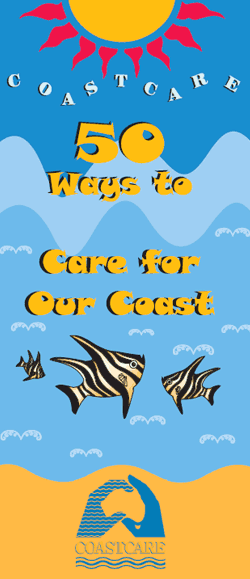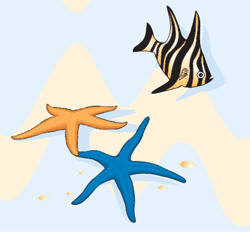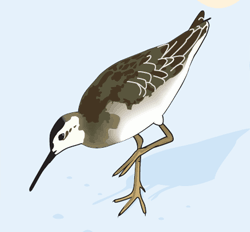50 Ways to Care for Our Coast

Coastcare is a program of the Commonwealth Government's Natural Heritage Trust in partnership with State/Territory and Local Governments.
Clean beaches... Clear Water... A wide variety of marine life...
Australians have come to expect these things from the coast.
There are warning signs that unless we start to take more responsibility for the coast that some of what we take for granted will not last. The pressure that is being placed on our coasts each year is enormous and impacts are increasing due to our expanding population.
The way that we use the coast will determine what is left for future generations.
This guide shows 50 ways that we can minimise our impact on coastal environments while enjoying what our coasts have to offer.
Remember to report stranded or dead marine animals to the appropriate authority. If you want to help make a difference join a Coastcare or conservation group.
Every little bit helps.
Look after yourself
The coastline provides many opportunities for enjoyment and there are a number of ways in which you can make your visit a safe one.
ANIMALS found in intertidal and coastal areas are usually harmless to people but there are some which are potentially dangerous.
- Learn to recognise possible animal hazards and do not pick them up or handle them. These include octopi, cone shells, sea jellies (jellyfish) and other marine stingers.
- Make sure you can always see where you place your hands. Octopi, including the potentially dangerous blue ringed octopus, rest in dark crevices, discarded cans and tyres.
- Wear adequate protective footwear when exploring intertidal rockpools and other coastal environments. Some animals have spines which can penetrate skin if stood on. Some spines may be poisonous. Many shells and rocks also have sharp edges which can easily cut skin. Be extra careful on slippery rocks if there are large waves.
SUNBURN will occur all year round when skin is exposed to the sun for long periods.
- Ensure adequate protection from the sun, by wearing a hat, loose clothing and sunscreen.
COASTAL CLIFFS can be extremely fragile. Many are quite unstable and can collapse without warning.
- Avoid standing close to under the edges of sea cliffs or under overhangs.
WAVES AND TIDES are changing all the time.
- Be careful of waves, especially when fishing and exploring rock platforms. Watch for the tide coming in.
Boating
Boating is a great way to explore the coastal environment. However, boating can also be an environmental hazard if certain basic practices are not followed.
- Garbage on boats should be stored in a strong reusable bag or a covered bin for safe disposal on land.
- Take cans rather than bottles on board. Empty cans are easily crushed and stored and use less space than bottles when empty.
- Remove all plastic packaging before materials are stored or taken on board.
Plastic bags can be swallowed and cause blockage of the stomach or intestines of marine animals. - Clean bilges and sumps out regularly on land. These areas collect oil which may leak into the water.
- Launch and retrieve your craft at designated launching ramps to avoid destroying native vegetation.
- Place anchors correctly and securely and obey no anchorage signs. Damage to reefs and seagrass beds occurs when anchors are allowed to shift. Use moorings where available.
- Use a holding tank for sewerage to avoid polluting water. Dispose of wastes properly. Use pump out facilities where they are available.
- Avoid injuries to dolphins and seals by slowing down when you see them. Prevent injuries to dolphins riding on bow waves by avoiding sudden turns.
- Give whales and dolphins plenty of space if seen. Never approach closer than 100 metres and leave them alone if they show signs of agitation (such as diving or rapid changes in direction).
Protected Areas
Some parts of the coast are designated as Marine Protected Areas for the protection of animal and plant communities, as well as historical and cultural relics. These include Marine Parks, Aquatic Reserves, Marine Reserves, Intertidal Protected Areas, Heritage Sites, Shipwrecks, Coastal Parks and Reserves,
and some National
Parks. Within these protected areas there are usually regulations which may relate to the protection of plants and animals.
These may include:-
- restriction on the activities allowed in these areas
- restrictions on boat speeds
- prevention of the removal of some types of material including plant and animals
- restrictions on the types of fish that can be caught
- restrictions on the use of fire, camping and vehicles.
- Find out the regulations that apply within these areas from the relevant authority in your state.
- Do not disturb rock shelters, shell middens, stone arrangements and rock art left by the ancestors of today's Aboriginal people. All are protected by law.
- Leave relics of early settlers so we can learn about the past.
- Shipwrecks should be left as found, as important archaeological information is lost if a site is disturbed. If a wreck is discovered contact the relevant authority.

The Living Coast
Our coast supports a huge variety of animals and plants. Some live entirely in the water whilst others may spend all or part of their time on the land fringing the coast.
A Habitat = A Home
A habitat provides the right combination of food and protection for living things to survive.
By conserving coastal habitats we help to protect many animals and plants.
A number of coastal habitats are especially sensitive to disturbances by humans. Take special care in these areas.
Sensitive Habitats
SAND DUNES are held together by the plants that grow on them. They are extremely sensitive to foot and vehicle traffic. Once the vegetation is removed there is little to prevent the sand from blowing away.
- Avoid damage to sand dune plants by walking on tracks when going to or from the beach. Make sure all vehicles are driven and parked in designated areas.
- Use the beach not the sand dunes when picnicking or playing.
Shell Collecting
Many marine snails produce beautiful shells that come in a wide range of colours, shapes and sizes. Empty shells are used by many animals, including hermit crabs, for protection.
- Leave some shells on the beach for use by other animals for shelter.
- Collect only empty shells. Shells that contain live animals will die if removed from their habitat and soon become extremely smelly.
Some areas are closed to the collection of all shells, live or dead.
Fishing
Many coastal animals can be used as food. These include fish, crabs, prawns, rock lobster and shellfish such as abalone, mussels, oysters and pippies.
- Know the regulations that apply to collecting animals including fish, abalone, crayfish, pippies and other shellfish. Some areas are totally closed and no collecting/fishing is allowed.
- Return undersized or unwanted fish to the water as soon as possible to avoid the unnecessary death of animals. Handle fish with wet hands to avoid rubbing protective slime off scales.
- Dispose of unwanted or tangled fishing lines, nets and bait packages on land as they can be lethal to fish, marine mammals, birds and reptiles. Land disposal sites attract birds and animals, wrap unwanted fishing line and nets to avoid entangling them.
- Collect only the bait that you need. Some bait species are protected. Know the regulations on bait collection. There are many alternatives to live bait such as steak, chops, bread dough, fish guts and tripe - try some!
- Spear fishing is prohibited in many areas for a number of species.
Pollute or Protect
"We can all continue to enjoy the best our coastal environments have to offer if we Care for Our Coast"
Rubbish on beaches is unattractive, dangerous and unhealthy. Some rubbish can take a long time to break down and can kill wildlife.
- If you have carried it in... carry it out. Go one step further. Remove rubbish left by others - if you don't who will?
- Ensure that all rubbish is disposed of properly on land.
- Minimise the amount of rubbish generated by reusing bags and recycling containers.
- Don't bury rubbish - it will soon be uncovered by the tide, animals or peoples' feet.
- When fishing, don't leave bait wrappers or fishing tackle around.
- On boats ensure that all rubbish is collected and returned for proper disposal on the land.
Most coastal pollution originates on land. Rubbish thrown onto streets or oil on the road is washed into storm water drains and eventually into the sea. Materials put down the sinks and toilets may also end up in the sea. Here are some things you can do at home to care for our coast.
- Make sure all rubbish goes into bins for correct disposal or recycling. Don't let it get washed down the gutter into a drain.
- Engine oils must not be poured into drains but returned to a garage for recycling.
- Fix up oil leaks on your car.
- Dispose of unwanted chemicals responsibly. Petrol, paints, thinners, pharmaceutical drugs, and garden pesticides and herbicides must not go into the sewers or drains. Your local council can give advice on their safe disposal.
- Use cleaning products that have minimum impact on the environment by breaking down quickly. Check the packet to see if it is biologically soft and has little or no phosphate content.
- Avoid overuse of chemical fertilisers. Nutrient runoff into water from urban and agricultural land is a major cause of excessive algal growth.
- Put waste fats and oils into a container not down the sink. Do not pour milk down the sink. These can be thrown out with other household garbage.
Coastal Birds

Many sea birds and waders make their home on sand dunes, rocky outcrops, offshore islands and beaches. While some birds make their nests on the ground others use burrows in the sand.
- Many birds abandon their nests if disturbed. Feeding birds can lead to the spread of disease or malnutrition. Please do not feed them.
- Sea bird colonies should be avoided during the nesting season. These colonies are sensitive to disturbance by people.
- Leave domestic animals at home or ensure they are under total control. Many sea and wading birds are vulnerable to attack from domestic animals, particularly dogs and cats.
- Avoid walking in areas where there are burrows for birds like penguins and shearwaters.
- Look out for and avoid walking on eggs that have been laid on the ground. Many sea birds like terns, pelicans, gulls, gannets and plovers nest directly on the ground.
